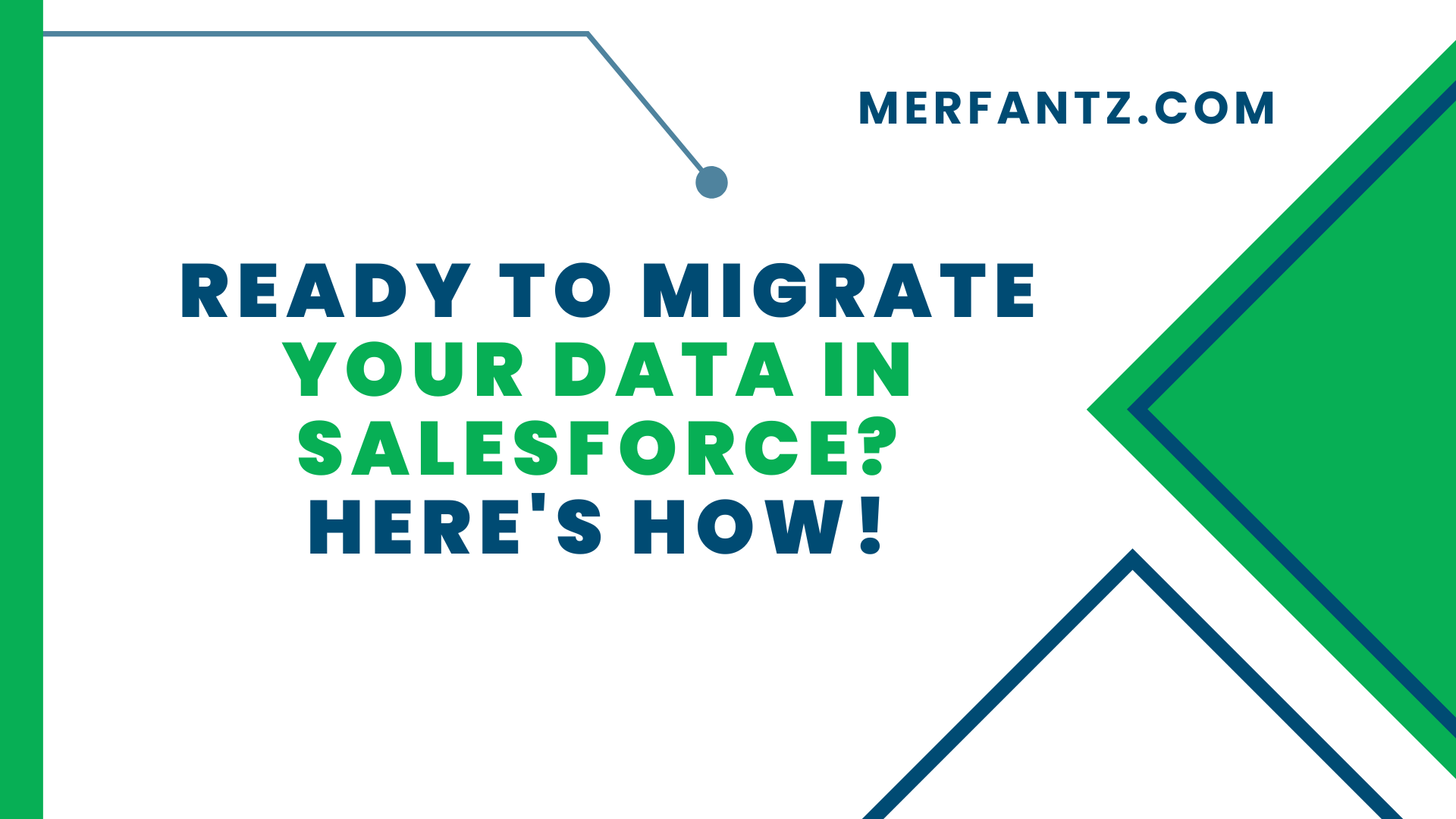Introduction
Welcome to Merfantz Technologies’ comprehensive guide on Salesforce Implementation. If you’re considering migrating your data to Salesforce, you’re taking a significant step towards streamlining your business processes and enhancing customer engagement. In this blog, we’ll walk you through the essential steps involved in data migration and help you understand the importance of this crucial process in Salesforce.
Understanding Data Migration
What is Data Migration?
Data migration is the process of transferring data from one system or platform to another, such as moving your existing customer information, sales records, and other critical data to Salesforce. During this process, data integrity and accuracy are of utmost importance to ensure a smooth transition and to avoid data loss or duplication.
Importance of Data Migration in Salesforce
Data migration lays the foundation for successful Salesforce implementation. By migrating your data correctly, you empower your organization with a unified and centralized database, enabling seamless collaboration, efficient reporting, and improved decision-making. It also ensures that your team can fully leverage the robust capabilities of Salesforce, enhancing overall productivity and customer satisfaction.
Preparing for Migration
Data Assessment and Cleanup
Before embarking on the migration journey, it’s crucial to conduct a thorough data assessment. Identify the quality and relevance of your existing data and implement a data cleanup process to eliminate duplicates and outdated information. A clean dataset ensures that your Salesforce instance starts on the right foot, maximizing its potential.
Mapping Data Fields and Relationships
Mapping data fields from your current system to their corresponding fields in Salesforce is a critical task. Careful planning and understanding of data relationships are necessary to ensure that information is accurately translated and seamlessly integrated into Salesforce. Proper mapping streamlines the migration process, reducing the chances of data errors.
Choosing the Right Migration Approach
Manual Data Migration vs. Automated Migration Tools
When it comes to data migration, businesses have two primary options: manual migration or using automated migration tools. Manual migration involves the manual transfer of data, which can be time-consuming and error-prone. On the other hand, automated migration tools offer efficiency and accuracy, simplifying the process and reducing the risk of data inconsistencies.
Selecting the Best Data Migration Strategy
Every business is unique, and the best migration strategy for one may not work for another. Determining the right approach requires a careful evaluation of your data volume, complexity, and resources. Collaborating with experienced Salesforce consultants, like Merfantz Technologies, can help you choose the most suitable strategy for your organization.
Data Security and Compliance
Ensuring Data Privacy During Migration
Data security is of paramount importance during the migration process. Safeguarding sensitive information and adhering to data privacy regulations are crucial for maintaining customer trust and complying with legal requirements. Implement robust security measures and encryption protocols to protect your data throughout the migration.
Complying with Regulatory Requirements
Depending on your industry and location, your business might be subject to specific data regulations and compliance standards. Ensure that your Salesforce implementation aligns with these regulations to avoid potential legal and financial implications. Partnering with a knowledgeable Salesforce implementation provider can assist you in navigating these complexities.
Executing the Migration Process
Creating Data Backup and Contingency Plans
Before initiating the actual data migration, it’s essential to create a comprehensive data backup and contingency plan. This precautionary step ensures that even in the unlikely event of data loss or system failure during migration, you can quickly recover and resume operations with minimal disruption.
Running Test Migrations for Validation
Testing is a crucial phase of data migration. Conducting test migrations allows you to identify and resolve any potential issues before performing the final migration. It also provides an opportunity to validate data accuracy and ensure that all essential functionalities are functioning as expected in Salesforce.
Handling Data Integration Challenges
Resolving Data Format and Structure Issues
Data from various sources may have different formats and structures. During migration, discrepancies in data formats can lead to data misinterpretation. By utilizing data transformation techniques and establishing data integration best practices, you can overcome these challenges and achieve seamless data synchronization in Salesforce.
Overcoming Data Loss and Duplication Risks
Data loss and duplication are common concerns during migration. Implementing data validation protocols and deduplication procedures help in mitigating these risks. Addressing these challenges proactively ensures that your Salesforce instance is populated with accurate and reliable data.
Post-Migration Validation and Testing
Verifying Data Integrity After Migration
Once the migration is complete, it’s essential to verify the integrity of the migrated data. Thoroughly validate the data to ensure its accuracy and consistency across all records. This step guarantees that your Salesforce instance contains trustworthy data that can be utilized confidently in your daily operations.
Conducting User Acceptance Testing (UAT)
User Acceptance Testing (UAT) involves having key stakeholders and end-users evaluate the Salesforce implementation. This testing phase provides valuable feedback, helping you identify any usability issues or process bottlenecks. By incorporating user feedback, you can fine-tune the Salesforce environment to meet your organization’s specific needs.
Training and Adoption Strategies
Training Employees on New Salesforce Features
Successfully adopting Salesforce requires comprehensive training for your team. Provide thorough training sessions to ensure that your employees understand the platform’s features and functionalities. Well-trained users are more likely to utilize Salesforce effectively, leading to increased productivity and overall user satisfaction.
Driving User Adoption for Increased Productivity
User adoption is key to the success of your Salesforce implementation. Encourage and support your employees in using Salesforce for their daily tasks. Recognize and address any concerns they might have, emphasizing the benefits of the new system. A user-centric approach will foster greater enthusiasm and productivity among your team.
Optimizing Performance and Scalability
Fine-Tuning Salesforce Settings for Efficiency
Optimize your Salesforce settings to enhance performance and efficiency. Configuration adjustments can streamline processes and improve user experience. Regularly monitor and fine-tune the system to adapt to your evolving business needs and ensure optimum performance.
Planning for Future Data Growth
As your business expands, so will your data. It’s essential to anticipate and plan for future data growth to maintain Salesforce’s performance and scalability. Consider adopting data archiving and storage management strategies to manage large volumes of data effectively.
Expert Support and Resources
Leveraging Professional Services for Successful Migration
For a seamless Salesforce implementation, consider partnering with experienced Salesforce implementation experts like Merfantz Technologies. Our team of professionals can guide you through the entire migration process, providing insights, best practices, and solutions to make your transition a success.
Recommended Tools and Documentation for Data Migration
Access valuable resources and tools to support your data migration journey. From data migration software to comprehensive documentation, leveraging the right resources ensures a well-informed and efficient migration process.
Frequently Asked Questions (FAQ) – Salesforce Implementation
What is Salesforce implementation, and why is it important?
Salesforce implementation refers to the process of setting up and configuring Salesforce according to your organization’s specific requirements. It involves migrating data, customizing the platform, and training users to leverage its capabilities effectively. Salesforce implementation is crucial as it allows businesses to streamline their processes, improve customer engagement, and gain valuable insights from data, ultimately driving growth and success.
How long does a typical Salesforce implementation take?
The duration of a Salesforce implementation can vary based on several factors, such as the complexity of your organization’s needs, the amount of data to be migrated, and the scope of customization required. A straightforward implementation for small businesses may take a few weeks, while larger enterprises with more intricate requirements might take several months. Working with experienced Salesforce implementation experts can help in estimating a realistic timeline based on your specific situation.
What are the potential challenges during Salesforce data migration?
Data migration poses several challenges, including data format discrepancies, data loss, and duplicate records. Data security and privacy concerns also need to be addressed during migration. Ensuring data accuracy and integrity is crucial for a successful migration.
How can I ensure a smooth user adoption of Salesforce in my organization?
Smooth user adoption is essential for maximizing the benefits of Salesforce. Offer comprehensive training to your employees to familiarize them with Salesforce features and functionalities. Involve key stakeholders from the beginning and address their feedback to tailor Salesforce to meet their needs. Emphasize the benefits of Salesforce adoption to encourage enthusiasm among users.
How to do data migration in Salesforce?
Data migration in Salesforce involves preparing and cleaning the data, mapping data fields, choosing a migration approach (manual or automated), executing the migration process, and verifying data integrity post-migration.
What is the migration process in Salesforce?
The migration process in Salesforce includes data assessment, data cleanup, data mapping, data validation, and actual data transfer to Salesforce using either manual methods or automated migration tools.
How do you successfully migrate data?
To successfully migrate data, plan thoroughly, ensure data accuracy, perform test migrations, create backups, and consider leveraging professional services for expert guidance.
How to do data migration testing in Salesforce?
Data migration testing in Salesforce involves running test migrations with sample data, validating data accuracy, comparing results against source data, and resolving any discrepancies before the final migration.
Conclusion:
Congratulations! You’ve now gained a comprehensive understanding of Salesforce data migration and the critical steps involved in implementing Salesforce successfully. By following this guide and partnering with Merfantz Technologies, you can ensure a smooth and effective transition to Salesforce, empowering your business with a powerful platform for growth and success. Start your Salesforce implementation journey today and unlock the full potential of your data.
Author Bio
Co-Founder & CMO at Merfantz Technologies Pvt Ltd | Marketing Manager for FieldAx Field Service Software | Salesforce All-Star Ranger and Community Contributor | Salesforce Content Creation for Knowledge Sharing






